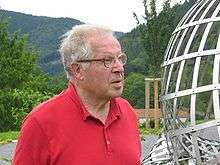Peter Swinnerton-Dyer
| Sir Peter Swinnerton-Dyer, Bt | |
|---|---|
 Peter Swinnerton-Dyer at the workshop "Explicit methods in number theory" in Oberwolfach, 2007 | |
| Born |
2 August 1927 Ponteland, Northumberland[1] |
| Residence | Thriplow, England[2] |
| Nationality | British |
| Fields | Mathematics |
| Institutions | University of Cambridge |
| Alma mater | University of Cambridge |
| Doctoral advisor | John Littlewood and André Weil |
| Doctoral students |
Mehran Basti Andreas Bender Andrew Bremner Martin Bright Jean-Louis Colliot-Thélène Miles Reid Walter Stothers Barry Tennison |
| Known for | Birch and Swinnerton-Dyer conjecture |
| Notable awards |
Pólya Prize (2006) Sylvester Medal (2006) |
Sir Henry Peter Francis Swinnerton-Dyer, 16th Baronet KBE FRS (born 2 August 1927), commonly known as Peter Swinnerton-Dyer, is an English mathematician specialising in number theory at University of Cambridge. As a mathematician he is best known for his part in the Birch and Swinnerton-Dyer conjecture relating algebraic properties of elliptic curves to special values of L-functions, which was developed with Bryan Birch during the first half of the 1960s with the help of machine computation, and for his work on the Titan operating system.
Biography
Swinnerton-Dyer is the son of Sir Leonard Schroeder Swinnerton Dyer, 15th Baronet, and his wife Barbara, daughter of Hereward Brackenbury. He was a Fellow of Trinity College, Master of St Catharine's College and vice-chancellor of the University of Cambridge from 1979 to 1983. From 1983 he was Chairman of the University Grants Committee and then from 1989, Chief Executive of the Universities Funding Council. He was elected Fellow of the Royal Society in 1967 and was a KBE in 1987. In 2006 he was awarded the Sylvester Medal.
Swinnerton-Dyer was, in his younger days, an international bridge player, representing the British team twice in the European Open teams championship. In 1953 at Helsinki he was partnered by Dimmie Fleming (the only occasion a woman has played in the British Open team): the team came second out of fifteen teams. In 1962 he was partnered by Ken Barbour; the team came fourth out of twelve teams at Beirut.[3] He was also a strong chess player and in matches represented Cambridge University on top board.
In 1981, he was awarded an Honorary Degree (Doctor of Science) by the University of Bath.[4]
Books
- Swinnerton-Dyer, H.P.F. (1974), Analytic theory of Abelian varieties, LMS Lecture Notes, 14, Cambridge University Press, ISBN 0-521-20526-3.
- Swinnerton-Dyer, Peter (2001), A brief guide to algebraic number theory, LMS Student Text, Cambridge University Press, ISBN 0-521-00423-3.
See also
- List of Vice-Chancellors of the University of Cambridge
- List of Masters of St Catharine's College, Cambridge
Notes
- ↑ Sleeman, Elizabeth (2003), The International Who's Who 2004, Routledge, ISBN 1-85743-217-7
- ↑ Peter Swinnerton-Dyer interviewed by Alan Macfarlane, 2008-05-12, retrieved 2009-07-31
- ↑ Hasenson P. British Bridge Almanack. 77, London. p400-1
- ↑ "Honorary Graduates 1989 to present". bath.ac.uk. University of Bath. Retrieved 18 February 2012.
External links
- Personal web page
- Number Theory and Algebraic Geometry -- to Peter Swinnerton-Dyer on his 75th birthday, edited by Miles Reid and Alexei Skorobogatov, LMS Lecture Notes 303, Cambridge University Press, 2004 ISBN 0-521-54518-8
- Weisstein, Eric W. "Birch/Swinnerton-Dyer Conjecture". MathWorld.
| Baronetage of England | ||
|---|---|---|
| Preceded by Leonard Schroeder Swinnerton Dyer |
Baronet (of Tottenham) 1975–present |
Incumbent |
| Academic offices | ||
| Preceded by Edwin Ernest Rich |
Master of St Catharine's College, Cambridge 1973–1983 |
Succeeded by Barry Supple |
| Preceded by Sir Alan Cottrell |
Vice-Chancellor of the University of Cambridge 1979–1981 |
Succeeded by Sir Harry Hinsley |
